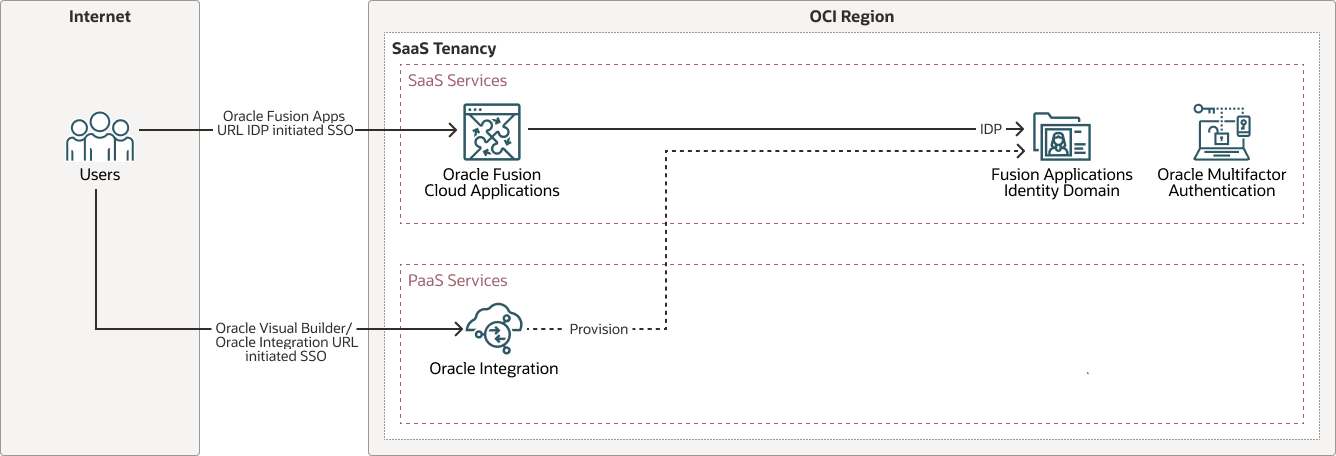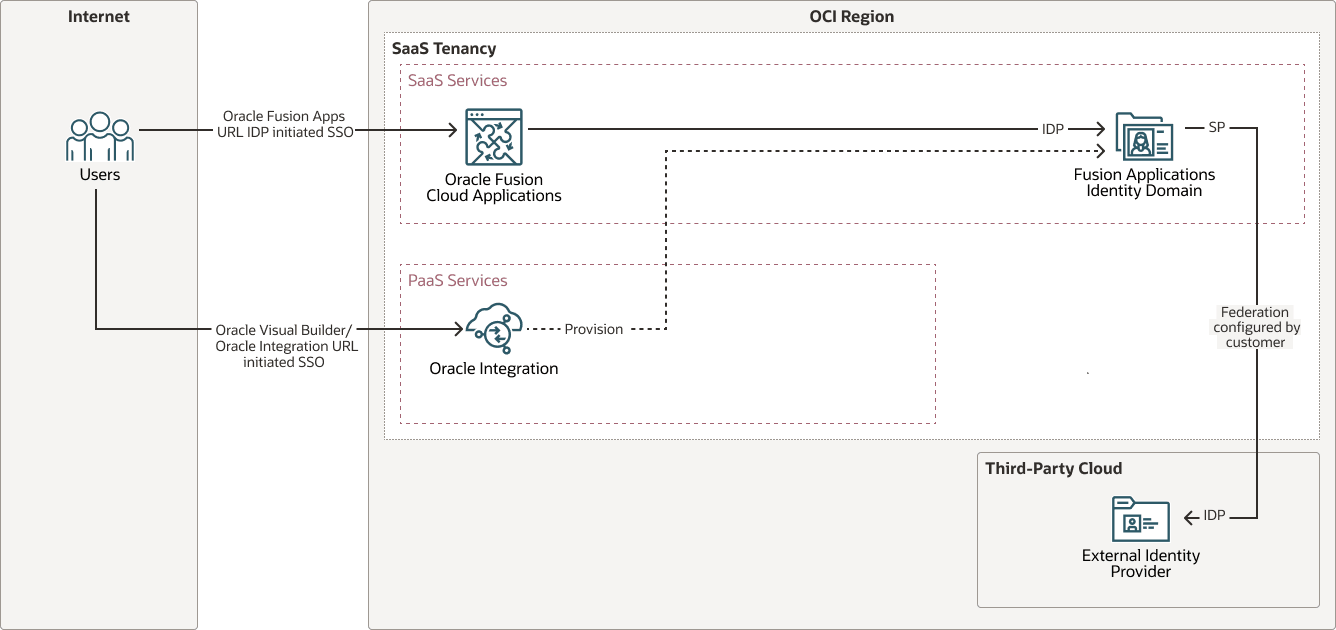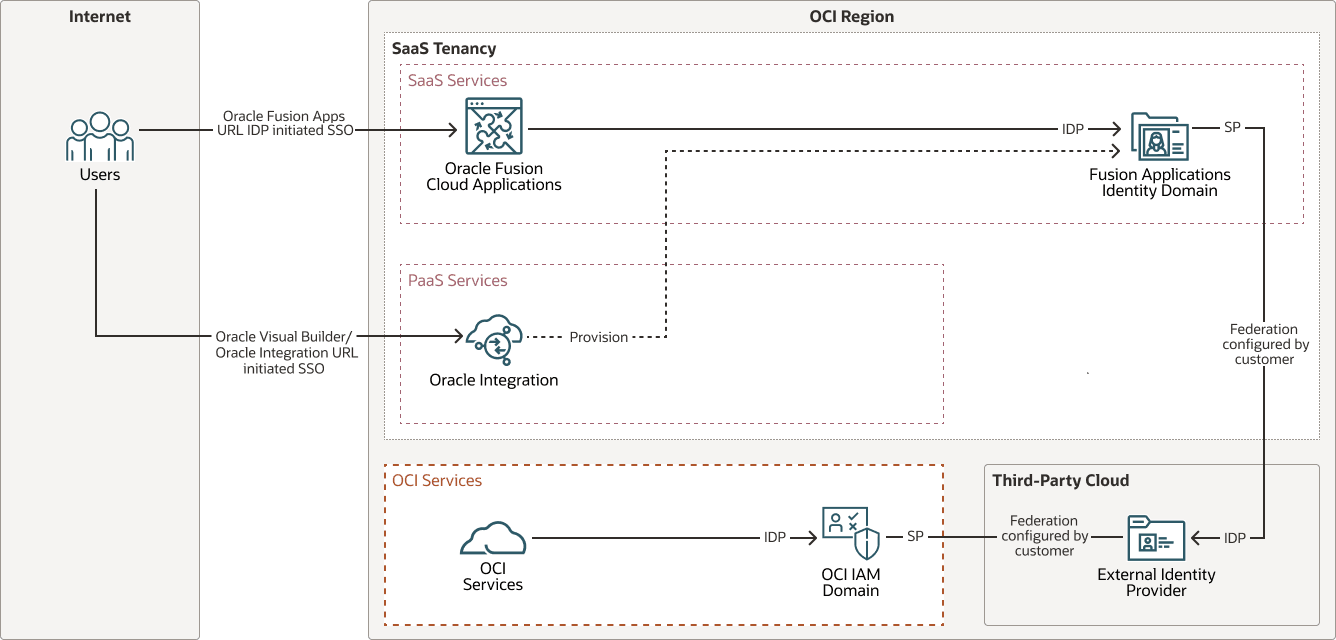Learn About SSO Between Oracle Integration and Oracle Fusion Cloud Applications
Configure single sign-on (SSO) between Oracle Integration and Oracle Fusion Cloud Applications so users don't have to reauthenticate when they access a process embedded in Oracle Fusion Applications.
SSO between Oracle Integration and Oracle Fusion Applications, such as, Oracle Customer Experience (CX), Oracle Fusion Cloud Enterprise Resource Planning (ERP), or Oracle Fusion Cloud Human Capital Management (HCM), offer significant advantages for businesses aiming to streamline operations, enhance security, and improve user experience.
Here are some key business use cases and benefits:
- Unified access across applications
Organizations utilizing multiple Oracle applications often require seamless navigation between these platforms. SSO enables users to authenticate once, and gain access to all integrated applications without repeated logins, enhancing productivity and user satisfaction.
- Enhanced security and compliance
Centralizing authentication through SSO allows for consistent enforcement of security policies, including multi-factor authentication (MFA) and risk-based access controls.
- Simplified user management
Integrating SSO facilitates streamlined user provisioning and deprovisioning. For instance, creating a user in Oracle Fusion Applications can automatically provision access in Oracle Integration, ensure synchronized user management, and reduce administrative overhead.
- Improved user experience
By reducing the need for multiple credentials and logins, SSO minimizes password fatigue and login errors, and leads to a more efficient and user-friendly experience.
This solution playbook outlines the recommended approaches for implementing single sign-on aligned with Oracle Fusion Applications.
Architecture
SSO with Oracle Fusion Cloud Applications identity domain
The Fusion Applications identity domain can deploy extensions and integrations, including provisioning Oracle Integration within the same domain. This approach eliminates the need to create additional OCI IAM identity domains, and helps you reduce both licensing costs and administrative overhead. Since the Oracle Fusion Applications identity domain is an Oracle App, extension use cases are supported without incurring extra costs, which minimizes operational and governance overhead. This involves provisioning Oracle Integration within the Oracle Fusion Applications identity domain.
The following diagram illustrates this authentication flow:
SSO with Oracle Fusion Applications identity domain and an external identity provider
If you already use an external identity provider (such as, Microsoft Entra ID or Okta) for your applications you can extend it as the identity provider for Oracle Fusion Applications and Oracle Integration. This approach centralizes user and access management, and also reduces duplication and administrative effort. You configure SSO with Oracle Fusion Applications identity domain as the service provider and your external identity provider. Oracle Integration is provisioned with Oracle Fusion Applications identity domain.
The following diagram illustrates this authentication flow:
SSO between Oracle Fusion Applications identity domain, an OCI IAM identity domain, and an external identity provider
The Oracle Fusion Applications identity domain can act as the identity store for managing users and groups specific to Oracle Fusion Applications and Oracle Integration. At the same time, a separate OCI identity domain can function as a centralized identity store to manage users and groups that require controlled access to OCI services such as OCI Object Storage, OCI Logging, and OCI Functions.
The following diagram illustrates this authentication flow:
Considerations for Oracle Fusion Cloud Applications
All Fusion Applications environments are provisioned with an OCI Identity and Access Management identity domain.
This identity domain is pre-integrated with Fusion Applications internal identity system and acts as the identity backbone for tools like Oracle Visual Builder Studio. Users created in Fusion Applications are automatically synchronized with this domain.
By default, federated SSO is configured, with Fusion Applications serving as the identity provider (IdP) and the Fusion Applications identity domain as the service provider.
Oracle Fusion Cloud Applications Identity Domain and Identity Upgrade
Oracle Fusion Cloud Applications are upgrading their user identity service to Oracle Cloud Infrastructure Identity and Access Management, with this transition being rolled out to existing Oracle customers over the coming quarters.
The new Oracle Fusion Cloud Applications identity domain in OCI will provide enhanced capabilities for authentication, sign-on policies, SSO, multifactor authentication, and identity lifecycle management. This upgrade designates the Oracle Fusion Cloud Applications identity domain as the identity provider for Oracle Fusion Cloud Applications.
For more information, see Identity Upgrade Overview in the Explore More section.
About Required Services, Products, and Roles
This solution requires the following services, products, and roles:
- Oracle Fusion Cloud Applications
- Oracle Integration
- Oracle Cloud Infrastructure Identity and Access Management
These are the roles needed for each service.
| Service Name: Role | Required to... |
|---|---|
| Oracle Fusion Applications: Application Administrator | Configure and test federated SSO configuration for Oracle Fusion Applications. |
| Oracle Integration: Service Administrator | Configure and test federated SSO configuration for Oracle Integration. |
| Identity Domain Administrator |
|
See Oracle Products, Solutions, and Services to get what you need.


